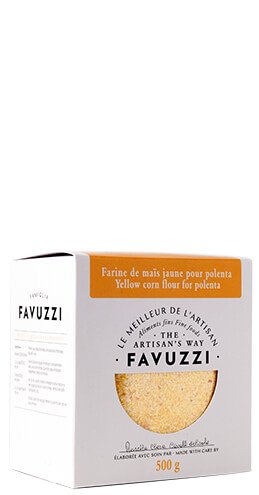Famiglia Favuzzi
Yellow corn flour for polenta
Description
Favuzzi corn semolina is ground in the traditional way with a stone mill, which gives it an interesting texture and a rich flavour. Its rough-ground kernels with blond tones resemble gold dust and distinguish it from industrial polenta with ultra-fine texture.
Uses
In Italian cuisine, corn flour is used in polenta recipes. There are many variations and interpretations of this preparation.
Yellow corn flour can also be found as a basic ingredient in other traditional dishes from different parts of the world: the American cornbread, the Brazilian bolo de fuba or the Mexican tortilla.
Distinctive Features
An unquestionable speciality of northern Italy, the so-called traditional polenta differs from the instant version by its exceptional taste, aromas and consistency.
Its qualities are conferred by the milling method used.
Stone grinding is the oldest and still the best method for producing flours and semolina. It preserves the nutrients contained in the germ and bran of the cereal, which gives the product a superior nutritional quality.
Thanks to this method, the semolina is very tasty, rich and digestible.
Artisan
Lucedio Abbey was founded in 1123 by Cistercian monks from Burgundy who reclaimed the territory and were the first to introduce rice culture in Italy in the 15th century. With nearly 900 years of history, the Principato di Lucedio farm extends over an area of more than 500 hectares in the heart of a regional park.
Origin
Lucedio Abbey, Trino, Piedmont, Italy.
Ingredients
Italian yellow corn flour.
May contain: Wheat, Cereals.
Conservation
Store in a cool, dry place away from light.

Lucedio Abbey was founded in 1123 by Cistercian monks from Burgundy who reclaimed the territory and were the first to introduce rice culture in Italy in the 15th century. With nearly 900 years of history, the Principato di Lucedio farm extends over an area of more than 500 hectares in the heart of a regional park.



